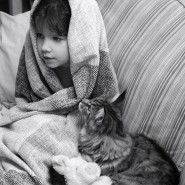
Iris has severe autism, and for the first few years of her life, she wasn’t able to communicate. But, when her family decided to get a cat, everything changed.
Iris’ mother, Arabella Carter-Johnson — who lives in Leicestershire, UK — wrote about her daughter’s bond with her pet cat, Thula and the dramatic impact it had on her life.
Before Thula, Iris’ parents found that she was “trapped in her own world, unreachable.” Iris didn’t look up when her mother entered a room, and she seldom smiled or spoke.
“Before Thula came into our lives Iris struggled to communicate with us, she mostly showed me what she wanted in a more physical way, pointing or taking me to things,” Carter-Johnson told Mashable.
Then, one day the family decided to get a cat, named Thula after one of Iris’ favourite lullabies. Iris had an immediate affinity with Thula and began to open up and communicate with her new companion in a way she hadn’t done before.
“After Thula, Iris started to use her voice much more and is now happy to tell me what she would like to eat, watch, do,” says Carter-Johnson.
“So many things changed after Thula came into our lives. Iris found sleeping very hard, but that improved right away. She would settle in the evening and be eager to get up in the morning to see her best friend.”
Research suggests that children with autism who have family pets tend to have greater social skills. A 2012 study showed an increase in prosocial behaviour in autistic children when a pet was introduced to the family. And, interestingly, the results showed that bonding was more prevalent in instances where pets were introduced into the family during childhood, rather than from birth.
In Iris’ case, introducing Thula into the family meant that she was happier to ride in the car; and haircuts and bath time — which had previously been traumatic — were no longer problematic.
“Iris also hated wearing tops, she started wearing clothes again. It was as if all these difficulties were being sorted one-by-one by her trusty companion,” says Carter-Johnson.
If Iris woke in the night, Thula was there to comfort her. Thula watched Iris as she played, and joined in whenever she could. When Iris stood at her table playing with play-dough, Thula sat by her side and mimicked her movements.
“They were comfortable around each other from the beginning and I didn’t have to do anything, which was a novelty,” says Carter-Johnson.
Iris began to talk to her very soon after she arrived and she would say “more cat” and “sit cat” giving her instructions about what she wanted her to do.”
Iris’ mum noticed a strong bond forming between the two, something she describes as “a powerful connection that we had been searching for all this time”.
Carter-Johnson noticed that her daughter was growing more and more affectionate towards the cat, massaging Thula’s paws and stroking her coat.
“Iris has become more openly affectionate to her dad, P-J, and more playful. She enjoyed games and all the silliness that we had wanted to experience with her for so long,” says Carter-Johnson.
Iris, who had previously disliked being hugged, kissed, or even talked to at times, began to laugh when her grandfather hugged her, and she would go over to him and take his hand to lead him on an adventure in the garden.
“It was as if she was opening up to all of us after Thula came into our lives,” Carter-Johnson continued.
“Iris is becoming more affectionate and over the last few days I have seen her hug and kiss her friend; something that doesn’t happen that often but a touching reminder of how much Iris appreciates her,” says Carter-Johnson.